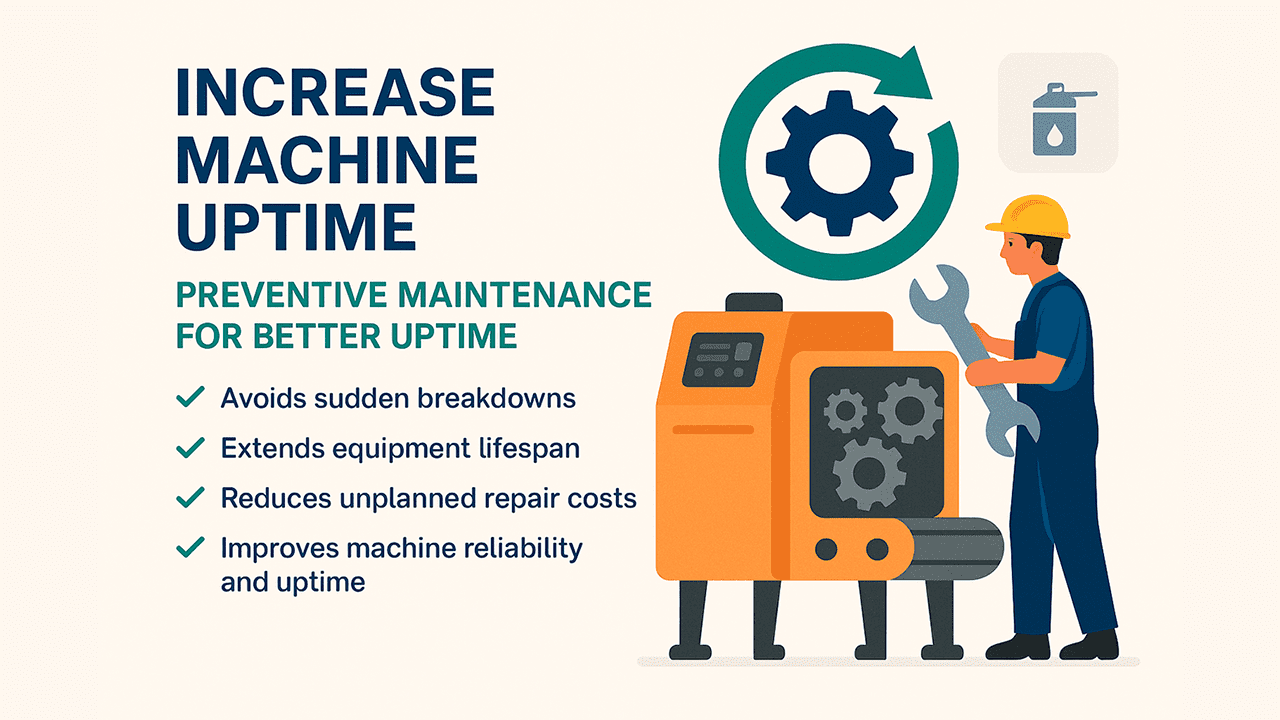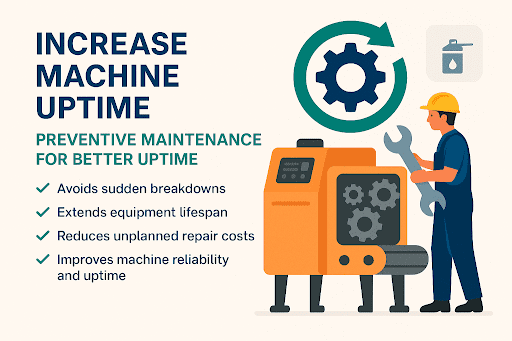 BACK TO Blog
BACK TO Blog
Asset Rental Management
Uncategorized
The primary performance metric for manufacturing operations, production facilities, and industrial settings is machine uptime. To Increase Machine Uptime, organizations must focus on ensuring continuous production, which enables both on-time delivery and reduced operational costs. Unexpected machine failures not only delay production and raise operational expenses but also lead to
- August 09, 2023
- Debraj Basu
- 7 minutes read

- August 09, 2023
- Debraj Basu
- 7 minutes read
The primary performance metric for manufacturing operations, production facilities, and industrial settings is machine uptime. To Increase Machine Uptime, organizations must focus on ensuring continuous production, which enables both on-time delivery and reduced operational costs. Unexpected machine failures not only delay production and raise operational expenses but also lead to unhappy customers.
In this guide, we’ll explore practical ways to Increase Machine Uptime and enhance overall equipment efficiency.
What is Machine Uptime and Why Does It Matter
The difference between a machine's planned and actual operating times is known as machine uptime. Improving this metric directly leads to:
- Meeting production goals
- Reducing downtime-related losses
- Boosting plant efficiency
- Ensuring customer satisfaction
To Increase Machine Uptime, businesses must maintain a balance between optimal machine use and smart maintenance strategies.
| Prevent Downtime before it starts. Stay prepared and organized with predictive maintenance strategies that boost uptime, reduce breakdowns, and support smarter, more efficient operations. |
Tips to Increase Machine Uptime and Efficiency
Here is a thorough analysis of the best strategies and tools to increase Machine Uptime and equipment efficiency:
1️. Preventive Maintenance for Better Uptime
The best approach to raise machine operational performance and increase machine uptime is by means of preventive maintenance . Scheduled maintenance tasks including inspections, lubrication, adjustments and component replacements done according to time schedules, usage patterns or performance standards define the approach.
Benefits of preventive maintenance for better uptime:
- Avoids sudden breakdowns
- Extends equipment lifespan
- Reduces unplanned repair costs
- Improves machine reliability and uptime
A well-planned preventive maintenance strategy ensures minimal disruptions and helps Increase Machine Uptime significantly over time.

2️. Predictive Maintenance for Proactive Action
Using real-time data, sensors, and analytics, predictive maintenance forecasts possible breakdowns before they happen, hence surpassing regular inspections. Monitor machine conditions like vibration, temperature, and pressure.Keep an eye on noise levels and energy consumption.This helps detect problems early and keep machines running smoothly.
By acting at the appropriate moment, businesses can avoid unwanted maintenance and surprise failures.
Benefits of predictive maintenance:
- Reduces unnecessary downtime
- Lowers maintenance cost
- Improves equipment reliability
- Increases operational safety
- Maximizes production uptime
With predictive maintenance, you're not just fixing machines—you’re preventing problems before they even start.
3️. Machine Performance Monitoring
Real-time machine performance monitoring allows one to track performance factors, equipment status, and operating conditions. Manufacturers benefit from continuous machine behavior data collection to reach:
- Detect anomalies early
- Identify performance bottlenecks
- Compare against baseline benchmarks
- Optimize machine usage
Consistent monitoring improves factory machine uptime strategies by providing insights into asset health, usage patterns, and productivity.
4️. Reduce Machine Downtime with Smart Scheduling
The production efficiency depends on how well machine maintenance and workloads are scheduled. Smart scheduling involves:
- Aligning maintenance with production windows
- Avoiding maintenance overlaps and conflicts
- Ensuring technician availability
- Minimizing machine overuse or idle time
How to reduce downtime in manufacturing involves finding the perfect balance between preventive tasks and operational demands.
5️. Improve Equipment Efficiency with Condition Monitoring
Condition monitoring uses sensors to track machine health factors like temperature, vibration, lubrication quality, and motor speed. This helps catch issues early and keeps equipment running efficiently.
The data analysis enables operators to prevent problems while enhancing machine efficiency and decreasing energy usage. Condition data enables proactive intervention, which maintains reliable equipment operation.
6️. Focus on Operator Training and Best Practices
Maintaining both machine uptime and operational efficiency depends mainly on technicians. Proper training ensures
- The technicians execute procedures according to established protocols.
- The equipment operates within safe parameters that prevent both overloading and misuse.
- Issues are reported promptly
- Preventive care tasks are performed routinely
The combination of workshops with certifications and operational guidelines helps maintain machine health while boosting productivity.
7️. Perform Regular Inspections and Tune-Ups
The Routine machine inspections and tune-ups help detect minor issues before they escalate. Checklists should include:
- Visual inspection of wear and tear
- Lubrication checks
- Calibration of sensors and gauges
- Checking for unusual noises or vibrations
- Inspecting belts, seals, and moving parts
Consistent inspections are a simple but important way to increase equipment reliability and maximize production uptime.
8️. Maintain Spare Parts and Inventory Management
Lack of spare components causes machine failures that lead to increased machinery inactivity. Efficient spare parts management safeguards:
- Critical components are always stocked
- Proper inventory levels are maintained
- Faster repair times when breakdowns occur
- No interruptions in maintenance schedules
The organization of parts according to usage rates and failure trends enables faster maintenance responses, which leads to increased machine uptime.
Machine Uptime Strategies for Factories
Manufacturing facilities increase machine uptime by using proactive, data-driven strategies such as:
- Preventive and predictive maintenance programs
- Condition-based maintenance alerts and monitoring
- Real-time performance dashboards for machine status
- Spare parts management to avoid repair delays
- Root cause analysis of equipment failures
- Operator training and regular machine calibration
These practices help maximize uptime and keep operations efficient. Integrating these strategies enhances operational resilience and equipment uptime.
Machine Efficiency Tips to Boost Uptime
If you’re looking to increase machine uptime and efficiency, try these practical tips:
- Lubricate moving parts and keep equipment clean
- Monitor vibrations for early fault detection
- Calibrate sensors and instruments regularly
- Replace worn or outdated components promptly
- Avoid continuous maximum load on machines
- Use high-quality spare parts and ensure proper alignment
- Track energy usage to improve overall efficiency
These simple habits can make a big difference in machine performance.
How to Reduce Downtime in Manufacturing?
Manufacturers must focus on minimizing downtime because it directly affects their ability to reach production targets and boost financial performance. To achieve this:
- Track downtime causes — Monitor reasons for breakdowns and delays.
- Analyze trends — Identify recurring issues and bottlenecks.
- Set KPIs and benchmarks — Define acceptable downtime limits and performance targets.
- Implement predictive maintenance — Use data to prevent future problems.
- Invest in training — Empower operators with skills and preventive habits.
- Schedule non-urgent maintenance smartly — Align tasks with low-demand production periods.
- Enhance spare parts availability — Keep essential components in stock.
Manufacturing productivity benefits from every small improvement in uptime operations.
Best Ways to Improve Machine Performance
The best methods to enhance machine performance include four key elements.
- Proactive Maintenance - Prioritize preventive and predictive maintenance programs.
- Operator Involvement - Train operators to recognize early signs of wear or inefficiencies.
- Data-Driven Insights - Monitor and analyze machine performance data continuously.
- Process Optimization - Optimize workflows, maintenance schedules, and machine setups.
Focusing on these areas helps factories avoid equipment failures and maximize production uptime.
Key Takeaways
Preventive and predictive maintenance are key to increasing machine uptime and efficiency through effective asset maintenance management software.
Businesses can reduce disruptions and catch issues early by scheduling maintenance, monitoring real-time performance, and aligning tasks with production. Training operators, organizing spare parts, and tracking failure trends further minimize downtime. These practices enhance asset maintenance management, boost equipment reliability, and create a more efficient, productive environment.
Your team, your equipment, and your bottom line will thank you.
Ready to Increase Machine Uptime and boost your operational efficiency?Start implementing preventive maintenance strategies today with DreamzCMMS! DreamzCMMS helps you:
Do not wait for the next breakdown.Start increasing your machine uptime today with smarter, preventive maintenance strategies. Your team, your equipment, and your production goals will thank you. Schedule a free consultation or demo with our DreamzCMMS experts now. |
Ready for More?
Talk to one of our CMMS experts and see how DreamzCMMS can simplify your maintenance operations.
Book a free consultation





